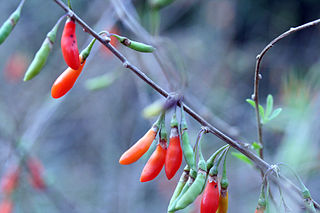
Lycium chinense is one of two species of boxthorn shrub in the family Solanaceae. Along with Lycium barbarum, it produces the goji berry ("wolfberry"). Two varieties are recognized, L. chinense var. chinense and L. chinense var. potaninii. It is also known as Chinese boxthorn, Chinese matrimony-vine, Chinese teaplant, Chinese wolfberry, wolfberry, and Chinese desert-thorn.

Codiaeum variegatum is a species of plant in the genus Codiaeum, which is a member of the family Euphorbiaceae. It was described by Carl Linnaeus in 1753. It is native to Indonesia, Malaysia, Australia, and the western Pacific Ocean islands, growing in open forests and scrub.

Scandix pecten-veneris is a species of edible plant belonging to the family Apiaceae. It is native to Eurasia, but is known to occur elsewhere. It is named for its long fruit, which has a thickened body up to 1.5 centimeters long and a beak which can measure up to 7 centimeters long and is lined with comblike bristles.
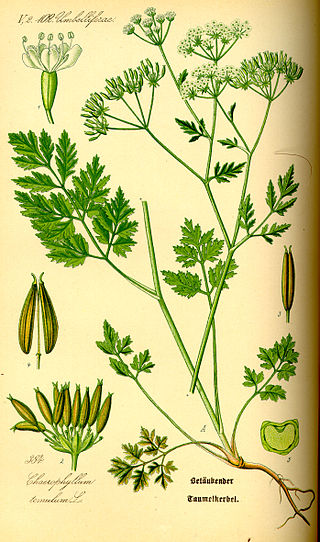
Chaerophyllum temulum, the rough chervil, is a species of flowering plant in the family Apiaceae.

Crinum asiaticum, commonly known as poison bulb, giant crinum lily, grand crinum lily, or spider lily, is a plant species widely planted in many warmer regions as an ornamental. It is a bulb-forming perennial producing an umbel of large, showy flowers that are prized by gardeners. However, all parts of the plant are poisonous if ingested. Some reports indicate exposure to the sap may cause skin irritation.

Bromus ciliatus is a species of brome grass known by the common name fringed brome. It is native to most of North America, including most of Canada, most of the United States except for some portions of the South, and northern Mexico. It is a plant of many habitats, including temperate coniferous forest. The specific epithet ciliatus is Latin for "ciliate", referring to the delicate hairs of the leaf blades.
Bulbophyllum xanthornis is a species of orchid in the genus Bulbophyllum.
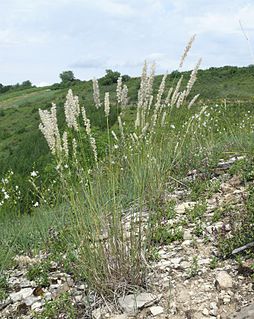
Melica ciliata, the hairy melic or silky spike melic, is a species of flowering plant in the grass family Poaceae, native to Europe, north Africa and temperate Asia. It has been introduced to South Australia.
Melica animarum is a species of grass that is endemic to Sierra de las Ánimas in Uruguay.
Melica longiflora is a grass species in the family Poaceae that is endemic to Chile where it can be found from Coquimbo to Talca.
Melica spartinoides, is a species of grass in the family Poaceae that is endemic to the Brazilian state of Santa Catarina.
Melica hyalina is a species of grass found in Brazil and southern South America.
Melica glabrescens is a species of grass found in Buenos Aires and Río Negro, Argentina.
Melica paulsenii is a species of grass endemic to Chile where it grows along the coastal cordillera at 50–700 metres (160–2,300 ft) above sea level.
Melica patagonica is a species of grass that is endemic to South America.
Melica parodiana is a species of grass found in Buenos Aires, Argentina and Uruguay.
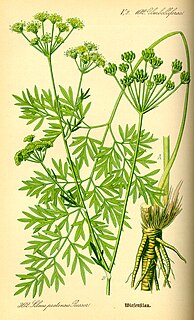
Silaum silaus, commonly known as pepper-saxifrage, is a perennial plant in the family Apiaceae (Umbelliferae) found across south-eastern, central, and western Europe, including the British Isles. It grows in damp grasslands on neutral soils.
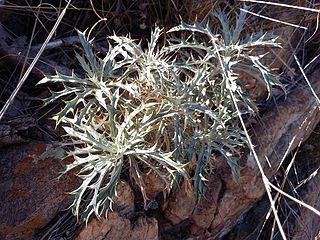
Berkheya carlinopsis Welw. ex O.Hoffm. is a Southern African herb or subshrub belonging to the family Asteraceae (Compositae) and was first described in 1896 in Boletim da Sociedade Broteriana 13 34.
A perennial herb or subshrub up to c. 1.5 m. tall. Stems branched, whitish araneose-tomentose, or glabrescent, leafy. Leaves sessile, 3–6 cm. long, dentate to pinnatifid-dentate; lamina 2–3(4) mm. wide and linear or 5–15 mm. wide and lanceolate; teeth 3–8 on each side, each tooth 2–6(10) mm. long, triangular or linear and extended in a tawny spine 2–3 mm. long; margins of teeth and sinuses entire or armed with smaller spines; upper surface smooth or somewhat scabrous, slightly to densely araneose-tomentose or glabrescent; lower surface whitish felted-tomentose. Capitula radiate, solitary and terminal on the branches, or subcorymbosely arranged, 2.5–5(+?) cm. in diam. including the rays. Phyllaries spreading, felted-tomentose outside, subglabrous or glabrous inside, 10–20 x 1–3 mm., linear-lanceolate, spiny-acuminate, ciliate-spinescent on the margins with spines 1–3 mm. long; the outermost phyllaries ± leaf-like with small spine-tipped teeth; inner phyllaries smaller and less spinescent-ciliate. Margins of the receptacular alveolae extended into straw-coloured bristles 1–2 mm. long. Achenes 1.5–3.5 mm. long, turbinate, 8–10-ribbed, strigose-sericeous, glandular-viscid at the apex. Pappus scales 2-seriate, 1–1.5 mm. long, narrowly oblong, acute or subobtuse, denticulate towards the apex.
Saposhnikovia divaricata, known as fángfēng防風 in Chinese, bangpung in Korean, and siler in English, is the sole species in the genus Saposhnikovia. The plant is still frequently referenced under the obsolete genus name Ledebouriella in many online sources devoted to traditional Chinese medicine.

Atractylodes macrocephala Koidz., bái zhú 白术 is a species of Atractylodes that grows in central China. The roots are consumed as a Chinese herbal medicine.









